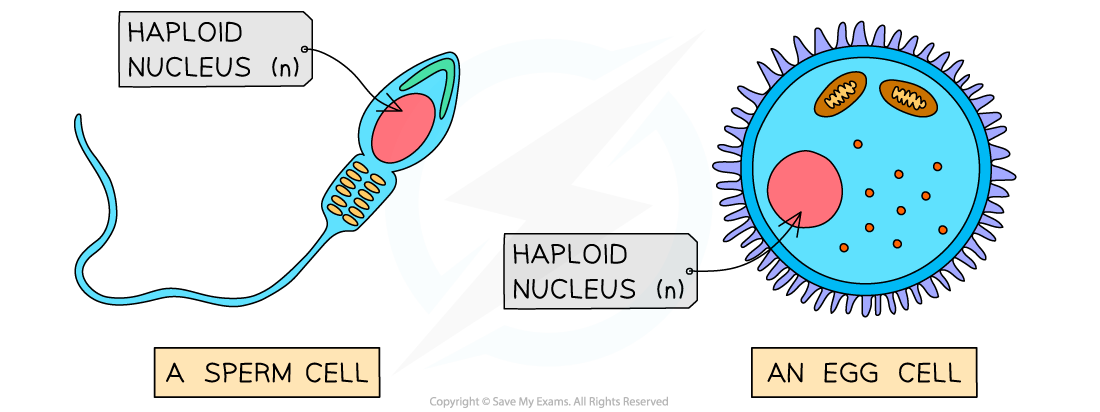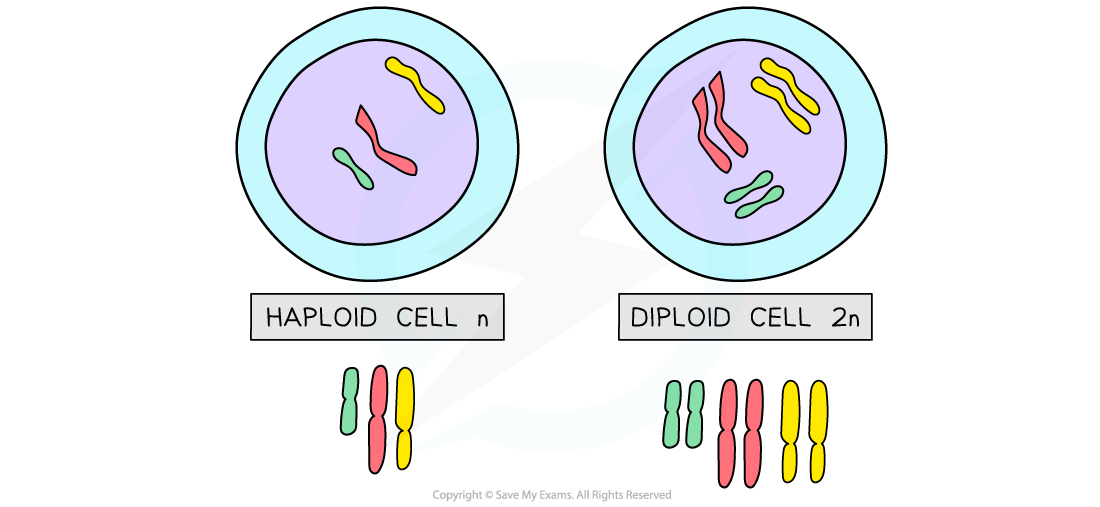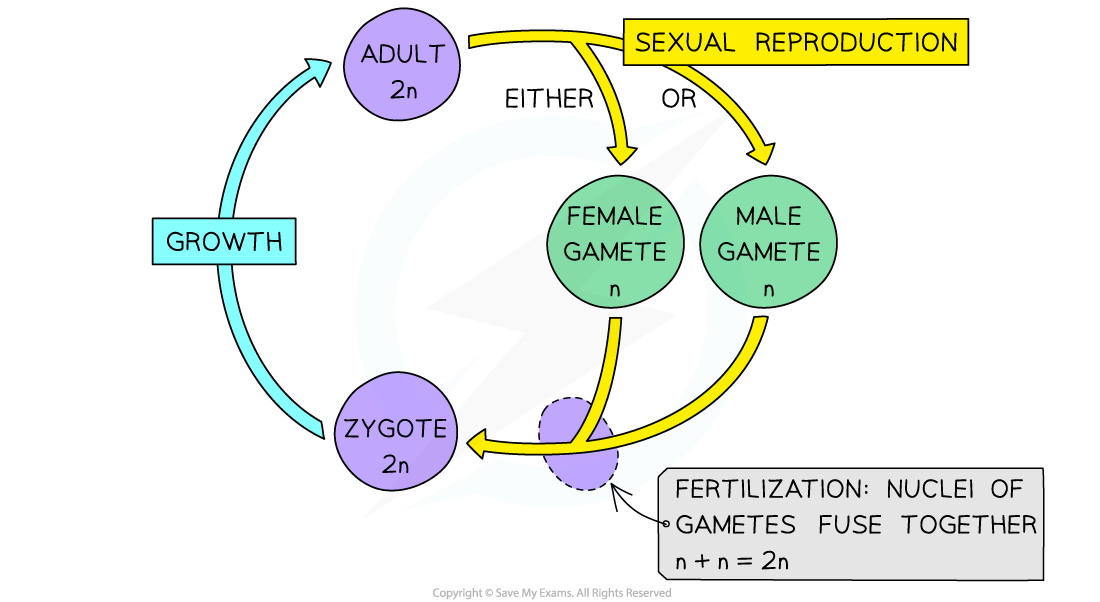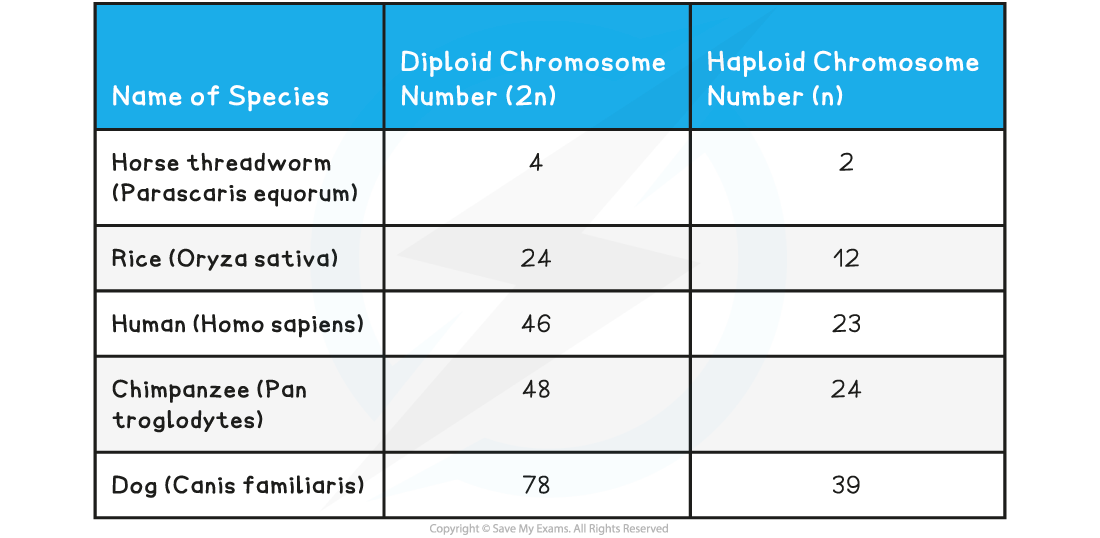Haploid
Haploid nuclei have one chromosome of each pair
- Haploid cells contain one complete set of chromosomes (n)
- In other words, they have half the number of chromosomes compared to normal body cells
- Humans have haploid cells that contain 23 chromosomes in their nucleus
- One chromosome from each pair
- n = 23
- These haploid cells are called gametes and they are involved in sexual reproduction
- In animals, they are the female egg and the male sperm

Gametes are haploid cells
Diploid
Diploid nuclei have pairs of homologous chromosomes
- A diploid cell is a cell that contains two complete sets of chromosomes (2n)
- These chromosomes contain all the DNA necessary for protein synthesis and cell function
- A diploid cell (zygote) is formed from the fusion of two haploid gametes at fertilisation
- Nearly all cells in the human body are diploid with 23 pairs (46 in total) of chromosomes in their nucleus
- Red blood cells are an exception to this rule because they do not contain a nucleus
- 2n = 46 in humans
- Having two alleles gives some protection from harmful mutations that are recessive
- There is a copy of the correctly-functioning allele still present
- Hybrid vigour is often observed in individuals with two different alleles, and can be seen as strong growth and general good health

Haploid (n) and Diploid (2n) cells
Number of Chromosomes
The number of chromosomes is a characteristic feature of members of a species
- During fertilisation the nuclei of gametes fuse together to form the nucleus of the zygote
- Both gametes must contain the same number of chromosomes in order for the zygote to be viable. If a zygote has too many or too few chromosomes it may not survive
- For a diploid zygote this means that the gametes must be haploid
- n + n = 2n
- Meiosis produces haploid gametes during sexual reproduction
- The first cell division of meiosis is a reduction division (reduces the number of chromosomes)
- This is a nuclear division that reduces the chromosome number of a cell
- In humans, the chromosome number is reduced from 46 (diploid) to 23 (haploid)
- The reduction in chromosome number during meiosis ensures the gametes formed are haploid
- Sometimes during evolution, there can be a change in the number of chromosomes a species has; these events are very rare
- Bread wheat (Triticum aestivum) is a species with six sets of chromosomes (6n)
- These changes didn't occur randomly but were intentionally bred by humans to produce ideal characteristics in the bread wheat

The maintenance of chromosome number through reduction division in a mammalian life cycle
Comparison of Chromosome Numbers
Comparison of diploid chromosome numbers of humans, chimpanzees, dogs, rice and horse threadworm
- These are their species binomial names
- Homo sapiens, Pan troglodytes, Canis familiaris, Oryza sativa, Parascaris equorum
- The number of chromosomes possessed by different species varies and is dependent upon changes that have occurred during that species' evolution
- Each individual in a species always has the same number of chromosomes (other than in a few rare instances where a chromosome mutation has occurred)
- An analogy is a large, single book containing a trilogy (3) of shorter books; the shorter books could be published separately and still contain the same amount of information
- A comparison of the chromosome number of these five selected species can be found below:
Comparison of Chromosome Numbers Table

- Note that the diploid number must always be an even number
- This is because the diploid number (2n) must always be divisible by two to produce the haploid number (n)
- The haploid number must always be a whole number
- An interesting comparison to make is that the number of chromosomes a species possesses is not linked to how 'advanced' a species is in evolutionary terms
- Chimpanzees and dogs have more chromosomes than humans even though they have evolved to be less intelligent and complex than humans
Exam Tip
You may be asked to estimate the number of chromosomes that would be present in the haploid cell of a species. For example, dogs have 78 chromosomes in their diploid cells. When trying to find the number of chromosomes in their haploid cells simply remember that diploid is 2n and haploid is n, meaning you just need to divide the number of chromosomes by 2. So dogs have 39 chromosomes in their haploid cells!
